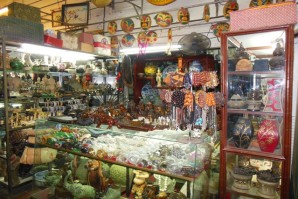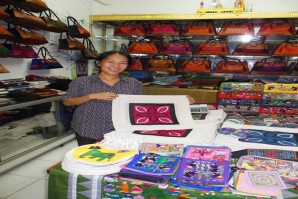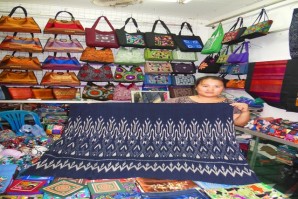Every Southeast Asian city has a market that’s a treasure trove of exotic bits and pieces; while Laos cannot rival the markets of Chiang Mai and Bangkok, in Vientiane Talaat Sao, or the morning market, offers a great selection of local offerings, mostly of the fabric-based kind.

The name is a bit of a misnomer, however, as many shops and stalls now stay open from early on until about 17:00. An indoor market, older mall and newer mall all fused together, Talaat Sao is the favoured shopping centre of locals and visitors alike.
Half of the indoor mall features household appliances and knock-off electronics and watches. There are occasional snack-stands in the peripheral areas and if you step into one of the motorbike parking lots, a couple of vendors are usually selling delicious Lao-style ice cream sundaes with coconut ice-cream, sticky rice, nuts and jelly sweets. If you’re feeling a bit more peckish, the market has food stalls in the basement at the very centre of the new building, facing the appliance section. Noodle soup and other standard fare is cheap, of reasonable quality — and heavily seasoned with MSG.
The bulk of the indoor market is the prime shopping area. Silk, cotton and embroidery are beautifully displayed in a vast array of lovely textiles, clothes and bags.
If you’re looking to buy a sinh, the traditional Lao skirt, there are endless choices of fabrics to chose from and many of the shops feature tailors who will fit it to your liking in a number of styles. If you’re looking for presents, stocking up on silk scarves is probably the most practical gift possible for lightweight travellers.Wooden boxes, bowls and carvings are scattered in various shops, and if you are fond of elephant motifs, you’ve come to the right place. There are also a number of curiosity shops with snakes in Lao whiskey and trinkets. At the far end of the market, near the corner of Lane Xing Avenue, clusters of old ladies sell Lao herbal remedies. They don’t speak any English, but if you’re interested in brewing some medicinal fire water, bring a bottle of Lao cao (Lao whiskey) and a willingness to gesticulate, and they’ll set you up with all matter of dried plants and animal parts.

The older mall is on the corner, opposite the bus station, and features three storeys of shops selling Western and Lao clothing plus electronic goods. The electronics are all Chinese knock-offs, many of them quite convincing. If you simply need parts for your phone, laptop or camera to sustain your travels, this is the place to come, but if you’re looking for high quality hardware, get it in Bangkok. The Western clothing is generally expensive, polyester and full of ruffles. This is not the place to buy T-shirts. However, if you’re looking for some more traditional styles, Lao Cotton on the ground floor has quality stuff, as do a few of the shops on the third floor.
The newer mall is an attempt to take standards up a notch, and featuresgold traders, high-end cosmetics, accessories and a better quality of electronics. Due to Laos’ high import taxes, this isn’t the country in which to buy luxury goods so skip the newer mall, unless you’re looking for some air-conditioning.

Nothing has price tags and costs are entirely open to negotiation. If you’re the haggling sort, expect to pay two-thirds of the asking price, and start by asking half. It’s always cheaper to buy multiple things at one shop, as vendors will be more inclined to bargain. While kip is the national currency, prices are often quoted in dollars or baht, so be sure to clarify which currency they are using when they quote you a price. Feel free to change to whichever currency is most convenient for you. Lao vendors each have their own style, ranging from the pushy to the entirely apathetic. Don’t be surprised if the family ignores you as they chow down for lunch on the shop floor, or if after lunch a stall is staffed simply by sleeping child.



